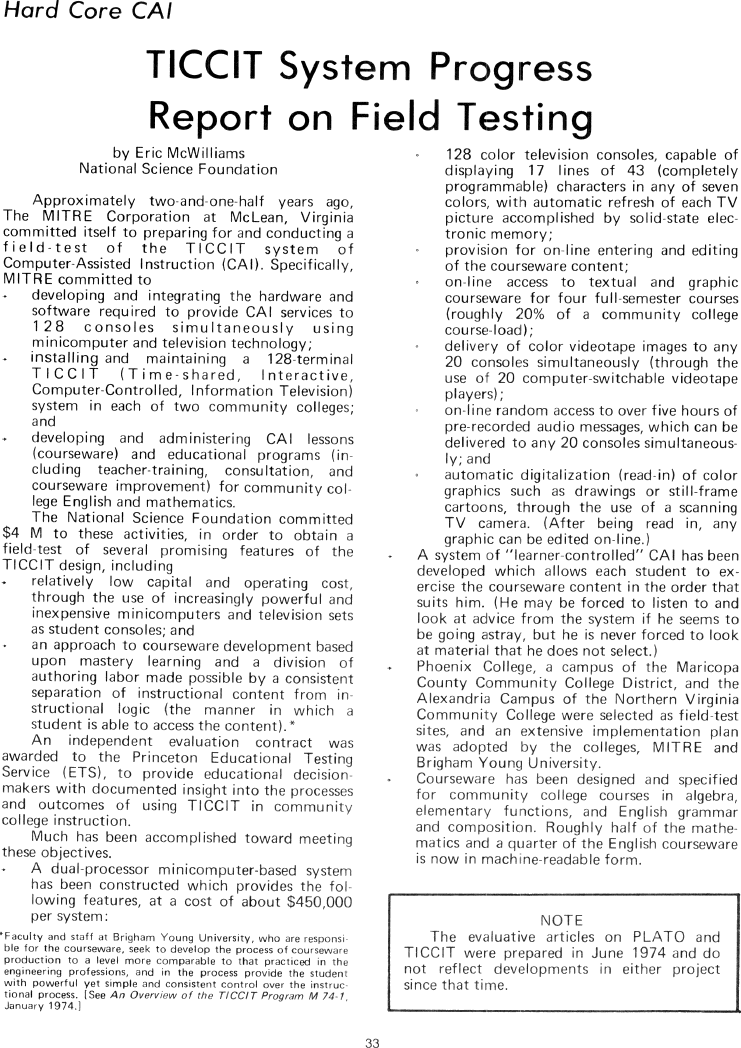The Best of Creative Computing Volume 1 (published 1976)
TICCIT System Progress Report on Field Testing (MITRE Corporation field-test of Time-shared Interactive Computer-Controlled Information Television system of Computer Aided Instruction in 1974)

Hard Core CAI
TICCIT System Progress
Report on Field Testing
by Eric McWilliams
National Science Foundation
Approximately two-and-one-half years ago,
The MITRE Corporation at McLean, Virginia
committed itself to preparing for and conducting a
field-test of the TICCIT system of
Computer-Assisted Instruction (CAI).
Specifically,
MITRE committed to
» developing and integrating the hardware and
software required to provide CAI services to
128 consoles simultaneously using
minicomputer and television technology;
»installing and maintaining a 128-terminal
TICCIT (Time-shared, Interactive,
Computer-ControlIed, Information Television)
system in each of two community colleges;
and
» developing and administering CAI lessons
(courseware) educational programs (including teacher-training, consultation, and
courseware improvement) for community college English and mathematics.
The National Science Foundation committed
$4 M to these activities, in order to obtain a
field-test of several promising features of the
TICCIT design, including
» relatively low capital and operating cost,
through the use of increasingly powerful and
inexpensive minicomputers and television sets
as student consoles; and
» an approach to courseware development based
upon mastery learning and a division of
authoring labor made possible by a consistent
separation of instructional content from instructional logic (the manner in
which a
student is able to access the content).*
An independent evaluation contract was
awarded to the Princeton Educational Testing
Service (ETS), to provide educational decision makers with documented insight
into the processes
and outcomes of using TICCIT in community
college instruction.
Much has been accomplished toward meeting
these objectives.
» A dual-processor minicomputer-based system
has been constructed which provides the following features, at a cost of about
$450,000
per system;
» Faculty and staff at Brigham Young University, who are responsible for the
courseware, seek to develop the process of courseware
production to a level more comparable to that practiced in the
engineering professions, and in the process provide the student
with powerful yet simple and consistent control over the instructional process.
[See An Overview of the TICCIT Program M 74-1,
January 1974.]
» 128 color television consoles, capable of
displaying 17 lines of 43 (completely
programmable) characters in any of seven
colors, with automatic refresh of each TV
picture accomplished by solid-state electronic memory;
» provision for on-line entering and editing
of the courseware content;
» on-line access to textual and graphic
courseware for four full-semester courses
(roughly 20% of a community college
course-Ioad);
» delivery of color videotape images to any
20 consoles simultaneously (through the
use of 20 computer-switchable videotape
players);
» on-line random access to over five hours of
pre-recorded audio messages, which can be
delivered to any 20 consoles simultaneously; and
» automatic digitalization (read-in) of color
graphics such as drawings or still-frame
cartoons, through the use of a scanning
TV camera. (After being read in, any
graphic can be edited on-line.)
»A system of "learner-controIIed" CAI has been
developed which allows each student to exercise the courseware content in the
order that
suits him. (He may be forced to listen to and
look at advice from the system if he seems to
be going astray, but he is never forced to look
at material that he does not select.)
» Phoenix College, a campus of the Maricopa
County Community College District, and the
Alexandria Campus of the Northern Virginia
Community College were selected as field-test
sites, and an extensive implementation plan
was adopted by the colleges, MITRE and
Brigham Young University.
Courseware has been designed and specified
for community college courses in algebra,
elementary functions, and English grammar
and composition. Roughly half of the mathematics and a quarter of the English
coursewareis now in machine-readable form.
NOTE
The evaluative articles on PLATO and
TICCIT were prepared in June 1974 and do
not reflect developments in either project
since that time.


